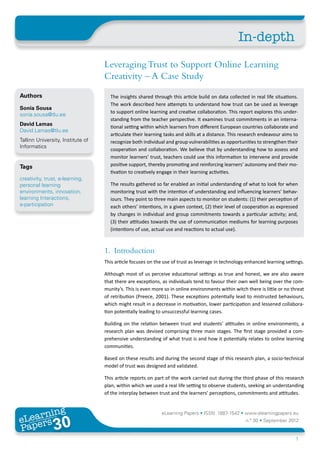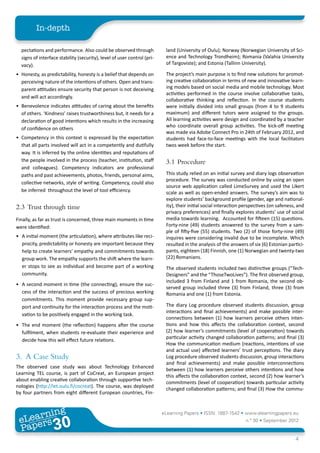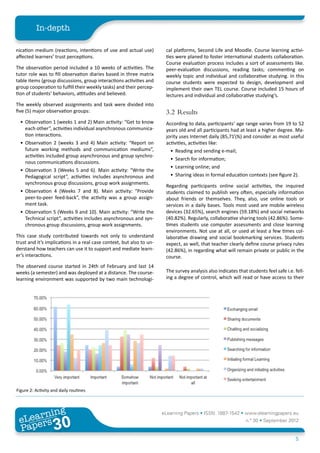This document discusses the role of trust in enhancing creativity within online learning environments through a case study. It examines how trust impacts learners' commitments, interactions, and perceptions while collaborating across different European cultures, aiming to develop tools for teachers to foster trust and collaboration. The research presents a socio-technical model of trust, emphasizing its importance in motivating learners and facilitating effective online education.







![In-depth
In return, tool familiarity and usefulness were important attrib-
utes for select the communication tool and to guarantee the References
communication efficiency. Safe communications were related Abdul-Rahman, A. & Hailes, S. (1999). Relying on trust
more with this attributes that privacy or tool secureness. towards reliable information. In: In: Proceedings | International
Symposium on Database, Web and Cooperative Systems
(DWACOS’99).
As future aims, towards this work is to develop a tool, which
support teachers on designing instruments and activities that Bacharach, M., Guerra, G., & Zizzo, D. J. (2007). The self-
foster students and group commitments. This tool aims as well fulfilling property of trust: an experimental study Theory and
Decision, pages 349–388.
to assess learners’ trust commitments during the articulation
and the connection phases so, it allows teachers to identify vari- Constantine, L.L. (2006). Trusted interaction: User control
ations on students’ trust commitments and apply interventions and system responsibilities in interaction design for information
systems. In: CAiSE. pp. 20-30.
if needed.
Dong, Y. (2010).The role of trust in social life. In Z.Yan, editor,
Trust Modeling and Management in Digital Environments: From
Social Concept to System Development, pages 421{440. IGI
Global.
Erikson, E.H. (ed.) (1968). Identity, youth and crisis. Free Press,
New York.
Fukuyama, F., editor (1995). Trust: The social virtues and the
creation of prosperity. Free Press, New York.
Falcone, R. & Singh, M. & Tan, Y. (eds.) Trust in cyber-
societies: integrating the human and artificial perspectives, pp.
27{54. Springer, Berlin (2002).
Gambetta, D. (1998). Trust making and breaking cooperative
relations. In Gambetta, D., editor, Can we trust trust?, pages
213–237. Basil Blackwell.
Garfinkel, H. (1963). A conception of, and experiments with,
Trust as a Condition of stable Concerted actions. Motivation and
social Interaction, Ronal Press, New York.
Giddens, A. (1991). Modernity and Self-identity. Polity-Press,
Cambridge.
Hoy, W. & Tschannen-Moran, M. (2003). The conceptualization
and measurement of faculty trust in schools: The omnibus t-scale.
In: Hoy, W., Miskel, C.G. (eds.) Studies in Leading and Organizing
Schools, pp. 181-208. Information Age, Greenwich [Online].
Available: http://communitiesofinquiry.com/
Kramer, R. (1999). Trust and distrust in organizations: Emerging
perspectives, enduring questions, volume 50. Academy of
Management, California.
Lave, L. & Wenger, E. (1990). Situated learning: legitimate
peripheral participation. In European Conference on Hypertext.
Lewicki, J. & Bunker, B. (1995). Trust in relationships: a model
of trust development and decline. In: Bunker, B., Rubin, J.Z. (eds.)
Conflict, cooperation and justice. Jossey-Bass, San Francisco.
Lewis, J. David & Weigert, A.J. (1985). Trust as a social reality.
Social Forces 63(4), 967-985.
ing
earn
eLearning Papers • ISSN: 1887-1542 • www.elearningpapers.eu
eL ers
30
u
ers.e
gpap
www
.elea
rnin n.º 30 • September 2012
Pap
8](https://image.slidesharecdn.com/in-depth302-121218115855-phpapp02/85/Leveraging-Trust-to-Support-Online-Learning-Creativity-A-Case-Study-8-320.jpg)
![In-depth
Luhmann, N. (2000). Familiarity, Confidence, Trust: Problems and Preece, J. & Shneiderman, B. (2009). The reader-to-leader
Alternatives, chapter 6, pages 94–107. Department of Sociology, framework: Motivating technology-mediated social participation.
University of Oxford, electronic edition. AIS Transactions on Human-Computer Interaction, 1(1):13–32.
McAllister, D. J. (1995). Affect and cognition-based trust as Pink, D.H. (2008). A Whole New Mind: Why Right-Brainers Will
foundations for interpersonal cooperation in organizations. The Rule the Future. Marshall Cavendish International.
Academy of Management Journal, 38(1), 24-59.
Solomon, G. & Perkins, D. N. (1998). Individual and social
McKnight, D. & Chervany, N. (2002). Trust and distrust aspects of learning. Review of Research in Education. 23, 1-24.
definitions: One bite at a time. In Falcone, R., Singh, M. P., and American Educational Research Association. [Online] Available:
Tan,Y., editors, Trust in cyber-societies: integrating the human and http://www.jstor.org/stable/1167286
artificial perspectives, pages 27–54. Springer, Berlin.
Sousa, S. C., Lamas, D., & Dias, P. (2011). The interrelation
Mcknight, Harrison & Chervany, N.L. (1996). The meaning of between communities, trust and their online social patterns. In
trust. Tech. rep., University of Minnesota - MIS Research Center. SCA2011 - International conference on Social Computing and its
Applications. IEEE Computer Society.
Meyerson, D. (1996). Swift trust and temporary groups. In:
Kramer, R., Tyler, T.(eds.) Trust in organizations: frontiers of theory Sousa, S., Lamas, David & Paulo, D. (2012). The Implications
and research, pp. 166{195. SAGE publications Inc., California. of Trust on Moderating Learner’s Social Interactions: A socio-
technical Model of Trust. The International Conference on
Mishra, A. K. (1996). Organizational responses to crisis: The Computer Supported Education (CSEDU 2012). SciTePress
centrality of trust. In Kramer, R. and Tyler, T., editors, Trust in Digital Library.
organizations: frontiers of theory and research, pages 261–287.
SAGE publications Inc., California. Tschannen-Moran, M. (2001). Collaboration and the need for
trust. Journal of Educational Administration 39(4), 308{331.
Moore, M. G. (1993). Three types of interaction, Distance
Education: new perspectives, Routledge, pp. 19–24. Walter, Frank & Battiston, S. (2008). A model of a trust-based
recommendation system on a social network. Auton Agent Multi-
O’Hara, K. (2009). A general definition of trust. Technical report, Agent Systems 16, 57-74.
University of Southampton - School of Electronics and Computer
Science. Weber, L.R. & Carter, A. (2003) The social construction of trust,
vol. 33. Springer.
Preece, J. (2001). Etiquette, empathy and trust in communities
of practice: Stepping-stones to social capital. Journal of Universal
Computer Science, 10(3):194– 202.
Edition and production
Name of the publication: eLearning Papers Copyrights
ISSN: 1887-1542
The texts published in this journal, unless otherwise indicated, are subject
Publisher: elearningeuropa.info
to a Creative Commons Attribution-Noncommercial-NoDerivativeWorks
Edited by: P.A.U. Education, S.L. 3.0 Unported licence. They may be copied, distributed and broadcast pro-
Postal address: c/Muntaner 262, 3r, 08021 Barcelona (Spain) vided that the author and the e-journal that publishes them, eLearning
Phone: +34 933 670 400 Papers, are cited. Commercial use and derivative works are not permitted.
Email: editorial@elearningeuropa.info The full licence can be consulted on http://creativecommons.org/licens-
Internet: www.elearningpapers.eu es/by-nc-nd/3.0/
ing
earn
eLearning Papers • ISSN: 1887-1542 • www.elearningpapers.eu
eL ers
30
u
ers.e
gpap
www
.elea
rnin n.º 30 • September 2012
Pap
9](https://image.slidesharecdn.com/in-depth302-121218115855-phpapp02/85/Leveraging-Trust-to-Support-Online-Learning-Creativity-A-Case-Study-9-320.jpg)